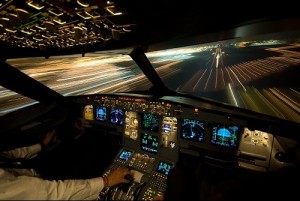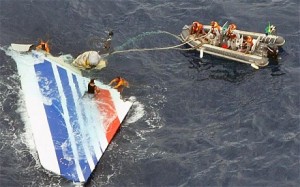“Pilots Rely Too Much on Automation,” trumpets a Wall Street Journal headline this week. Gizmodo.com puts it more bluntly: “Commercial Pilots Suck at Manually Flying Planes.”
A 277-page FAA report is the culprit referred to in these venerable—and not so venerable—publications (Gizmodo, after all, is mostly known for such scoops as, “How much would it cost to build the Starship Enterprise”, and “How much would it cost to to build the Death Star.”) With all due respect to the WSJ, the sensationalistic, knee-jerk media seem to be having a field day with this “bombshell.”
I think we can fairly ask: How true are these headlines, really? As a Captain for a major U.S. airline, on one of the most automated airplanes in history—the Airbus A320—I believe I can speak with authority on this issue. Indeed, I have flown the A320 class (A321 through A319) for nearly 20 years.
The exhaustive FAA report, to be discussed with industry leaders later this month, analyzed some 3,000 commercial flights worldwide, and apparently comes to the disturbing conclusion that the greatest danger in the sky today is the automated cockpit. Ironic, since the whole goal of automation in the cockpit has been to improve safety. The study appears to single out two main issues: over-reliance on automation, and inadequate training on increasingly sophisticated systems.
And sophisticated, the Airbus is. From the first few seconds after takeoff to the last few minutes before landing, nearly every pilot leaves the flying to Fifi (our affectionate name for the French-built Airbus, despite her automated male voice). Why? Because, when it comes to airliners, flying an airplane is nothing. Safely managing a flight is everything.
The moment I punch the FCU and leave the driving to Fifi, my mind’s tendency to tunnel vision suddenly expands to see the “Big Picture.” Rather than be distracted with the minutiae of keeping this speed, that heading and climbing to that altitude, my attention is freed up considerably by letting her do the dirty work. This situational awareness is critical to the safe handling of an airliner.
Moreover, when the sh*t hits the fan blades, I am a strong proponent of letting Fifi do the driving while my First Officer and I troubleshoot. To be sure, somebody is always flying the plane—that is, babysitting Fifi. In fact, our emergency procedures call for the Captain to run the checklists while delegating the relatively straightforward task of flying to the First Officer.
Major international A330 airline pilot, blogger and novelist Karlene Petitt, author of Flight for Control, says, “This is a new world we face—a battle between automation and proficiency. The real question is, How will we win this war without losing thousands of lives? Encouraging pilots to hand fly their planes is a great idea. Our training footprints must include rigorous sessions where pilots perform engine failures and emergencies without the autopilot, flight director and autothrust. But I have to ask, Do you want your pilot hand flying an approach to minimums after being awake for 14 hours on the back side of the clock in a state of exhaustion?” I agree. Under normal flight conditions, the autopilot greatly reduces pilot fatigue. After a long day of multiple legs, or international, back side of the clock flying, it is quite a treat—let alone safer—to let Fifi shoot the ILS through the snowstorm and autoland. Is this over-reliance on automation? I hardly think so.
Conversely, on occasion I do get myself into a situation where I have to “turn off the magic and fly.” Captain Mark L. Berry, major airline pilot, author of 13,760 Feet–My Personal Hole in the Sky, and Contributing Editor for Airways magazine, says, “When I taught the Boeing 767, one of the original ‘electric jets,’ I noticed that old-school pilots were quick to disconnect the then-modern automation and hand fly the aircraft. At our core, we are first and foremost pilots, not ‘automation engineers’.”
Again, I wholeheartedly agree. Nothing like a little old-fashioned stick and rudder to straighten the kinks out. Apparently, the FAA study has found that today’s pilots are reluctant to do this, stating they “lack sufficient or in-depth knowledge and skills.” Which leads us to our second issue: inadequate training on increasingly evolving automation.Two of the first Airbus accidents, the 1988 Air France Flight 296, an air show flyby-turned-PR-disaster, and Indian Airlines Fight 605 in 1990, as well as the more recent Air France Flight 447 crash on June 1, 2009, were all attributed—rightly or wrongly—to pilot error due to inadequate training and knowledge of the Airbus systems.
Airlines, I believe, do an adequate job of training today’s modern pilot. There is no getting around the proverbial “drinking from a firehose” that airline pilots are subjected to while training on a new airplane. And, in all the aircraft I’ve flown, the Airbus has far and away the biggest firehose from which to drown. The payoff, however, is worth every bit of saturation.
So,then, is the FAA report full of hot air? Is the greatest danger in the sky today the automated cockpit or not? Well, danger is a mighty loaded term. Is it more “dangerous” to land with your fly open or closed? What the study apparently fails to mention is the vast improvement of air safety with the advent of these highly sophisticated systems. Aircraft and aviation technology have evolved to the point where human beings are by far the weakest link in the safety chain. Ironically, pilots also remain its greatest asset.
But again, pilots are human. Automation or no, we make mistakes—on every flight. Even this report admits that the vast majority of observed errors were minor, and trapped by the pilots themselves before they could become big errors. And, as I mentioned earlier, when the magic is turned on, pilots can better see the Big Picture and more easily trap those errors.
As for the report’s remedies, however, I mostly agree.The first issue boils down to complacency. Pilots can become over-reliant on automation, get bored and forget to monitor. This is a constant human factor challenge for any pilot. As for the second issue, well, more systems and procedures training is always a good idea. Recently, in the “box,” we simulated the Air France 447 situation, and believe me, things get mighty confusing, mighty fast. Those pilots were fighting erroneous and conflicting instrument indications that quickly compounded. The lesson, again: stick and rudder. Turn off the magic and fly. That training, I assure you, was worth its weight in gold.
Dr. Martin Luther King, Jr. said, “The arc of the moral universe is long, but it bends toward justice.” Well, the arc of aviation safety is long as well, but it too has inexorably bent in the proper direction—to the point where one is 73 times more likely to die in an auto accident. To that end, what is most misleading about the FAA report are the sensationalized headlines surrounding it. Written by nonflying laymen who scream, “The sky is falling!,” they are oblivious to the fact that pilots—and their automated cockpits—have helped air travel become six times safer than your own bathtub.
Eric “Cap’n Aux” Auxier is an airline pilot by day, writer by night, and kid by choice. Pilot for a major U.S. airline, he is a freelance writer, novelist and blogger. He is a regular contributor to Airways Magazine.
His second novel, The Last Bush Pilots captured the coveted Amazon TOP 100 Breakthrough Novels, 2013. Mr. Auxier makes his home in Phoenix, Arizona.









